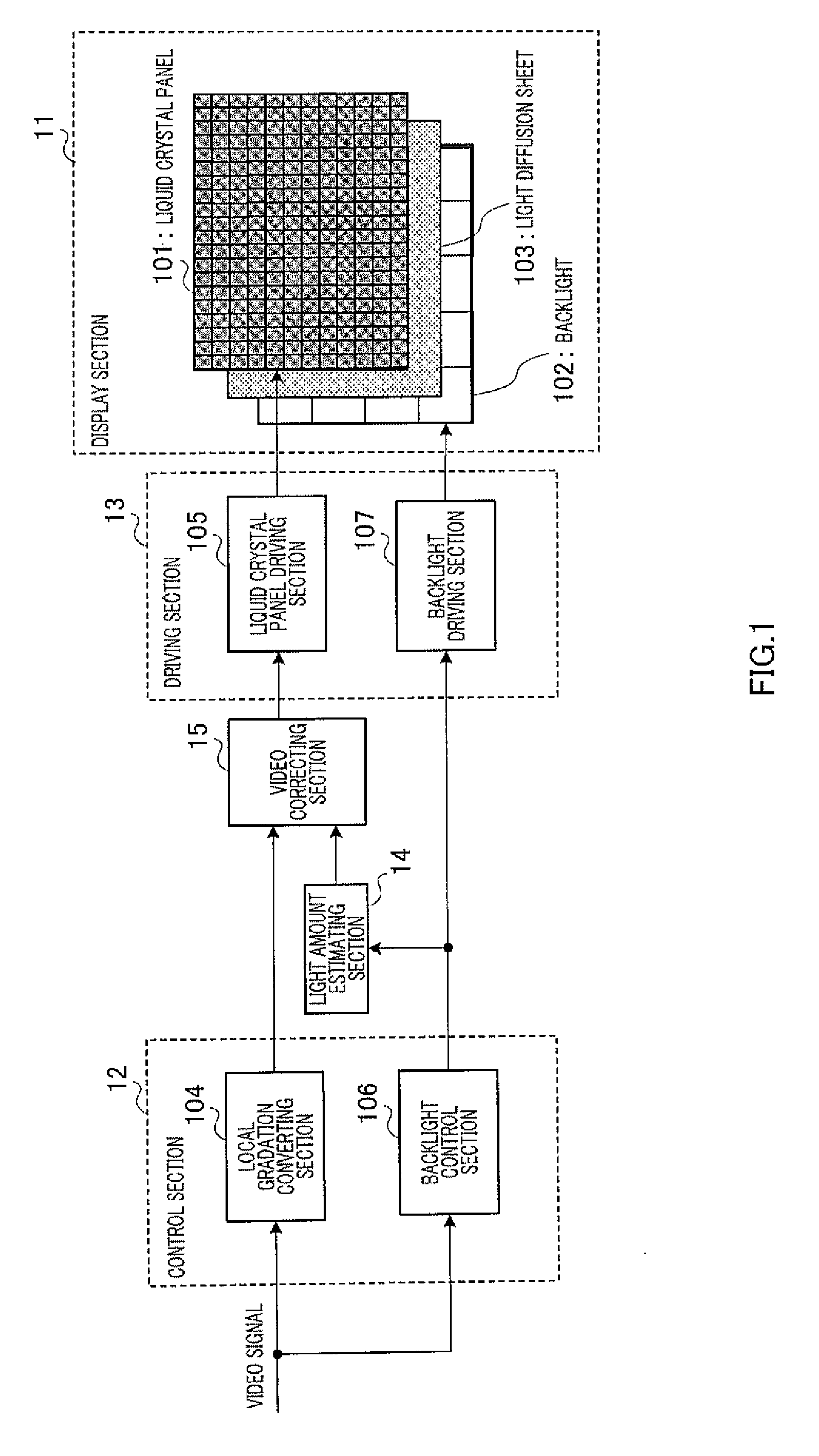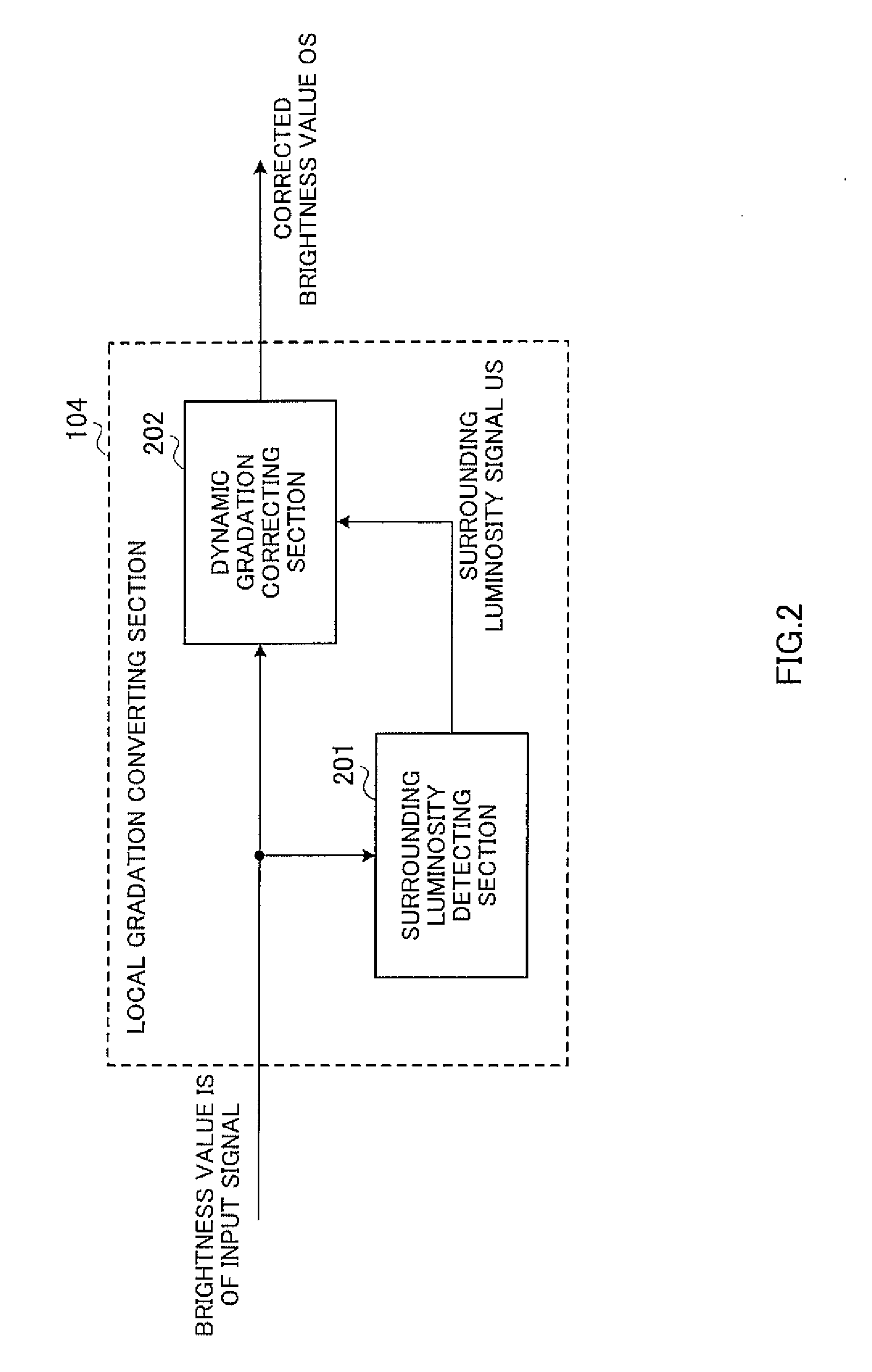Display device and display method
a display device and display method technology, applied in the field of display devices, can solve the problems of black not being fully reproduced, significant amount of power consumption waste, and significant proportion of backlight power consumption in the power consumption of the entire liquid crystal display apparatus, so as to compensate for image deterioration, uneven brightness, and decrease contrast
- Summary
- Abstract
- Description
- Claims
- Application Information
AI Technical Summary
Benefits of technology
Problems solved by technology
Method used
Image
Examples
embodiment 1
[0061]Next, an image display apparatus according to Embodiment 1 will be described with reference to the drawings.
[0062]FIG. 1 is a block diagram illustrating a configuration of the image display apparatus according to Embodiment 1.
[0063]The image display apparatus according to Embodiment 1 has display section 11, control section 12, driving section 13, light amount estimating section 14 and video correcting section 15. Further, display section 11 has liquid crystal panel 101, backlight 102 and light diffusion sheet 103. Further, control section 12 has local gradation converting section 104 and backlight control section 106. Furthermore, driving section 13 has liquid crystal panel driving section 105 and backlight driving section 107.
[0064]101>
[0065]Liquid crystal panel 101 modulates the illumination light radiated on its back face, according to a control signal input from liquid crystal panel driving section 105 to display an image on a screen which is the surface of liquid crystal...
embodiment 2
[0147]Next, an image display apparatus according to Embodiment 2 will be described with reference to the drawings.
[0148]FIG. 8 is a block diagram illustrating a configuration of the image display apparatus according to Embodiment 2.
[0149]The image display apparatus according to Embodiment 2 has display section 11, control section 12 and driving section 13. Further, display section 11 has liquid crystal panel 101, backlight 102 and light diffusion sheet 103. Further, control section 12 has local gradation converting section 104 and backlight control section 106. Furthermore, driving section 13 has liquid crystal panel driving section 105 and backlight driving section 107.
[0150]That is, the image display apparatus according to Embodiment 2 differs from the image display apparatus according to above Embodiment 1 in that light amount estimating section 14 and video correcting section 15 are not provided.
[0151]101>
[0152]Liquid crystal panel 101 modulates illumination light radiated on it...
embodiment 3
[0193]Hereinafter, Embodiment 3 will be described.
[0194]In Embodiment 2, the gradation characteristics in dynamic gradation correcting section 202 in local gradation converting section 104 are set based on the straight line connecting the “” symbols in FIG. 3, that is, a straight line of the inclination 1 passing the origin. This setting provides characteristics of enhancing only local contrast without changing a visual brightness.
[0195]However, when local dimming control is performed, a brightness value which varies per light emitting area of backlight 102 is set based on the brightness value of an input video signal. More specifically, a lower brightness value than the brightness value of the input video signal is set.
[0196]Therefore, when the transmittance of liquid crystal panel 101 is set based on the brightness value of the input video signal, the brightness value of the light emitting area of backlight 102 is lower, and therefore the brightness value displayed on liquid crys...
PUM
 Login to View More
Login to View More Abstract
Description
Claims
Application Information
 Login to View More
Login to View More - R&D
- Intellectual Property
- Life Sciences
- Materials
- Tech Scout
- Unparalleled Data Quality
- Higher Quality Content
- 60% Fewer Hallucinations
Browse by: Latest US Patents, China's latest patents, Technical Efficacy Thesaurus, Application Domain, Technology Topic, Popular Technical Reports.
© 2025 PatSnap. All rights reserved.Legal|Privacy policy|Modern Slavery Act Transparency Statement|Sitemap|About US| Contact US: help@patsnap.com



